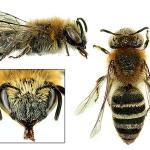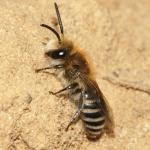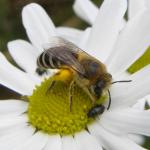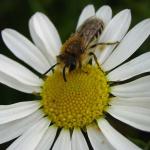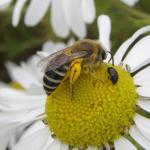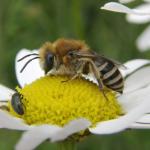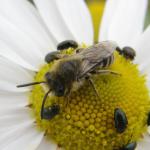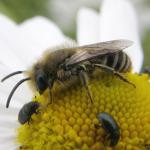Colletes daviesanus signatus VERHOEFF, 1890; Colletes canus GMELIN, 1790; Colletes inexpectatus NOSKIEWICZ, 1936; Colletes daviesanus tuberculatus MORAWITZ, 1894
Widely distributed throughout England, Wales and the Channel Islands, but scarce in Scotland, where it is known only from scattered coastal sites as far north as Invernesshire. Published records from the Outer and Inner Hebrides (Heslop Harrison, 1952) are almost certainly misidentifications of Colletes floralis. It is also scarce in Ireland, with records from Kilkenny, Wexford and Down. Widely distributed in Europe, occurring from Fennoscandia south to Austria and northern Italy, and east to Iran. Also reported from Mongolia and the Gobi.
This species is not regarded as being scarce or threatened.
Virtually ubiquitous in lowland Britain and it is the only Colletes regularly observed in urban localities, including private gardens.
Univoltine; mid June to mid September.
Most commonly nests in dense aggregations in sunlit, vertical surfaces such as coastal sandstone cliffs, sand pits, roadside cuttings, cob walls and in soft mortar joints of brickwork. The bee has gained some notoriety in undermining mortar joints, in extreme examples leading to serious weakening of masonry, with piles of excavated sand collecting at the bases of affected walls. Mader (1999) provides an exhaustive review of the nesting habits of this species in Germany. Individual nest burrows generally terminate either in a single cell or in a series of 4-10 consecutive cells (e.g. Blair, 1920; O'Toole & Raw, 1991), the convex base of each fitting into the concave lid of the previous cell. The winter is passed as a diapausing prepupa and perhaps occasionally as a young larva (Friese, 1912). The nesting behaviour of this species has been described in detail by Malyshev (1923).
Dropwort (Filipendula vulgaris), hogweed (Heracleum sphondylium), ragwort (Senecio species), daisy (Bellis perennis), yarrow (Achillea species), feverfew (Tanacetum parthenium), tansy (Chrysanthemum vulgare) and creeping thistle (Cirsium arvense).
Epeolus variegatus (Carr, 1916; Blair, 1920; Richards, 1937). The sarcophagid fly Miltogramma punctata is a well known parasitoid of the bee (e.g. Blair, 1920; O'Toole, 1986; G M Spooner and M Edwards pers. comm.). The beefly Bombylius minor has been reared from Colletes daviesanus cells (Blair, 1920).


